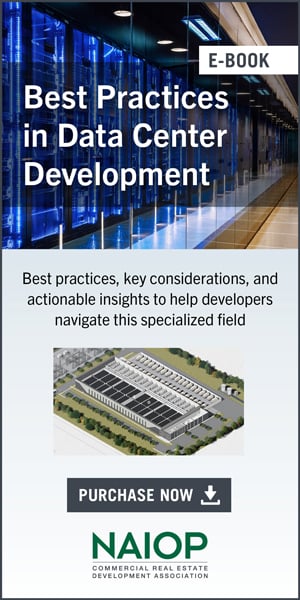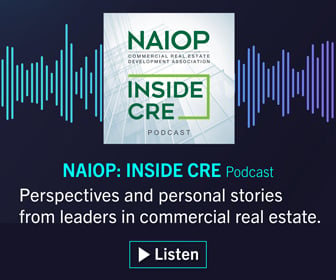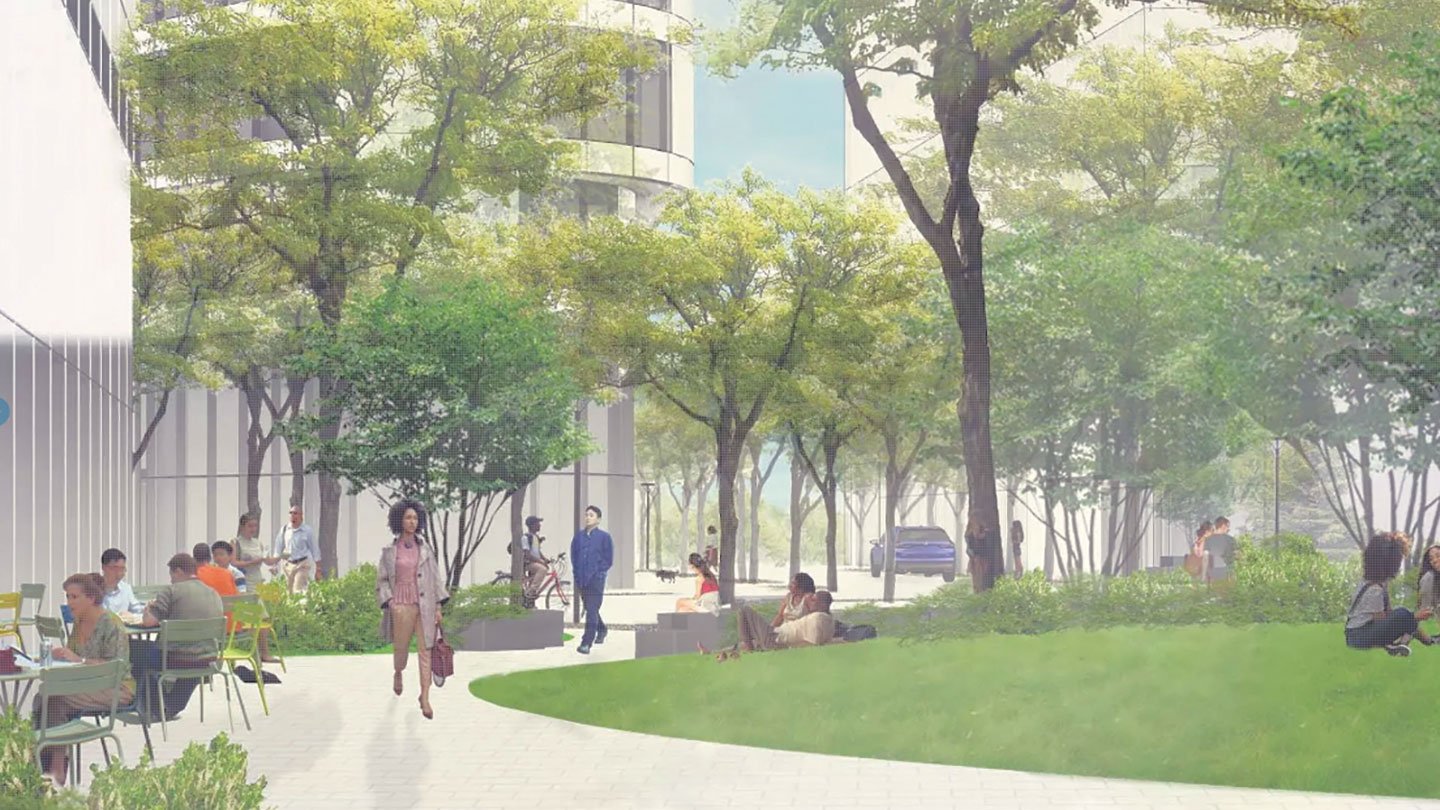
De-risking Retail Leasing and Entitlements Through Online Engagement
Greystar invites community input on retail decisions in a mixed-use development through a dedicated project website.
Getting the right mix of retail has proved to be no easy task for mixed-use developers in the years since the COVID-19 pandemic. When retail spaces sit vacant months after completion, developers face an unwelcome reality that — as Ann Ehrhart, CEO and founder of Everstreet, a Boston-based retail and restaurant brokerage and advisory firm, puts it — “If you build it, they may not come.”
In the face of this challenge, Ehrhart and the development teams with which she works are embracing new strategies to generate community support and enthusiasm for retail and mixed-use developments.
Project Background: 20-23 Cummings
In 2023, multifamily real estate firm Greystar began advancing proposals for a 1.25 million-square-foot mixed-use development in the Assembly Square neighborhood of East Somerville, Massachusetts. The currently underutilized site is occupied by a La Quinta hotel and vacant former restaurant and office space.
The Greystar team quickly learned that finding community members to engage with about its proposal — which recently received master plan approval — might pose a challenge. While the site is located within an existing commercial corridor, it is hemmed in by Interstate 93, the Mystic View Parkway and low-rise commercial storefronts.
A Somerville zoning ordinance required that 25% of the overall site, which will also include two lab office buildings and an approximately 200-unit hotel, be dedicated to public space. However, 20-23 Cummings doesn’t have any directly adjacent neighbors, so Greystar wondered how it could get community members from farther afield involved in the planning for the ground-floor retail and other public areas.
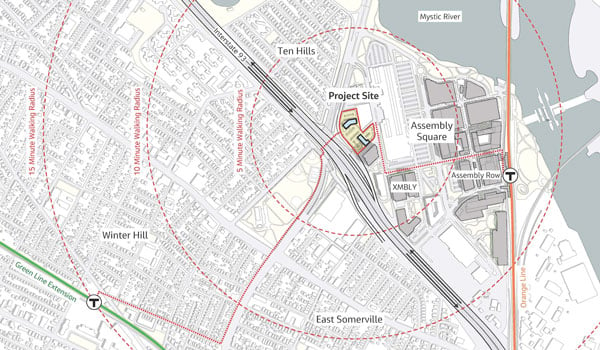
The site is hemmed in by Interstate 93, the Mystic View Parkway and low-rise commercial storefronts, but it also serves as a popular pedestrian cut-through to Assembly Square. Courtesy of Greystar
“We asked ourselves, ‘How do we get people engaged who won’t be affected day to day by this development but who visit Assembly Square or have an interest in how this project fits into the larger economic context of Somerville?’” said Ryan Souls, senior project manager at Greystar.
Testing a Thesis
To answer that question, the Greystar team enlisted Ehrhart, who speculated that engaging directly with communities about retail is the best way to get people excited about mixed-use development. The 20-23 Cummings project seemed like an ideal project to put that thesis to the test.
“One of the things that never really sat well with me in the traditional brokerage world was how merchandising typically excluded the primary stakeholders — which are the people on-site — from the conversation,” Ehrhart said. “This is even more important when you’re looking at an underutilized site. It’s critical to understand what is going to incentivize someone to change their habits and walk an extra block for retail.”
By having transparent conversations with stakeholders, Ehrhart theorized, the project team could supplement market data to validate its assumptions while simultaneously building excitement among individuals who might utilize the space.
Community Engagement: Goals and Challenges
To activate those conversations, Greystar reached out to coUrbanize, a community engagement platform that helps development and planning teams engage with people whose opinions are typically overlooked.
The Greystar team knew the Somerville community was highly engaged, civically minded and generally open to providing feedback when made aware of projects. Greystar was also aware the roughly 5,000 office workers in the surrounding buildings would be unlikely to attend public meetings since they typically leave the area after business hours.
“Rather than having directly impacted parties coming to us, we decided to reach out to parties who may have an interest — but not a natural inclination — to participate in the engagement process,” Souls said.
Outreach Strategies for Reaching Targeted Groups
The site is a prominent pedestrian cut-through between Assembly Square and the surrounding neighborhoods, so the development team installed a large in-ground sign asking passersby what kinds of local retail and restaurants are missing from the area. Respondents could text their feedback to a local phone number that automatically populated their response to the coUrbanize project website and encouraged them to sign up for email updates.
Project leaders also used their relationship with an existing neighborhood organization, East Somerville Main Streets, to raise awareness about the project website and how community members could influence future retail. Greystar co-sponsored the organization’s Foodie Crawl, where it shared information with attendees, conducted live polling and distributed postcards with QR codes that connected people to the website.
As manager of a nearby apartment building, Greystar was also able to activate its existing network of nearby residents with an email linking them directly to the online project forum, where residents could answer questions about their ideas for retail and public space, as well as see neighbors’ comments.
The Data: Community Engagement Outcomes
Over the course of five months, the team attracted nearly 1,000 unique visitors to the project website and received 185 responses in the feedback section. Some of these responses validated the development team’s previous market data regarding what community members wanted to see in the neighborhood — for example, a day care facility and a casual sit-down restaurant or brewery. Other responses suggested specific local businesses that would be a good fit.
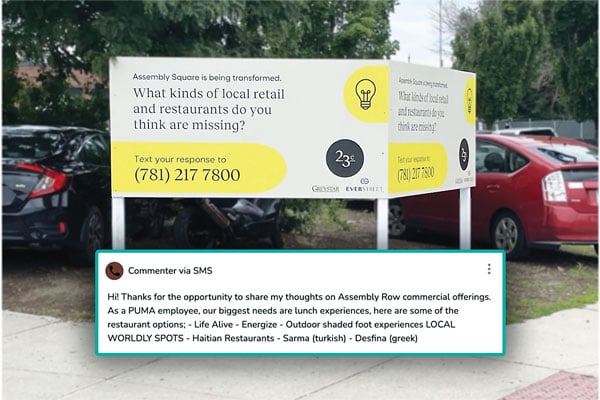
A text message sign in a high-traffic area encourages passersby to share their ideas, which populate directly to the project website. Courtesy of coUrbanize
“Hot lead — There is a local, founder-owned business that has several locations in the western suburbs … The Muffin House Cafe,” commented one user via the text message sign.
“Any concept with a kids’ play space where parents can get coffee or a drink, socialize and loosely supervise would absolutely print money in Somerville. People are constantly talking in the parenting groups about wanting a place like this,” wrote another user.
Using AI-generated data reports within the coUrbanize portal, the Greystar team was able to identify the top themes and subthemes pulled from community member comments and demonstrate that the public comment sentiment about the project was 87% positive or neutral.
Generating Excitement for Mixed Use
For Ehrhart, the data confirmed her thesis that delivering amenities that community members want and can use is the most efficient way to generate excitement — and smooth over any potential conflict about height and density — for mixed-use development.
“The project’s neighbors may never have a reason to go up into lab space, but they can use the retail every day. That’s something that can have a positive impact on their lives,” Ehrhart said. “We can dig into what people want and tailor the planning process to delivering that to them, with the understanding that none of those amenities pencil without the height and density.”
Research from the Initiative on Cities at Boston University has shown that the people who attend public meetings tend to be older, wealthier and more opposed to development than the average resident in the neighborhoods they represent. By capturing the opinions of community members who don’t typically attend public meetings, development teams can deliver a more representative collection of feedback during the entitlements process.
“The feedback has really fed into our initial design planning and how we’re looking at retail,” said Erin Corcoran, senior project analyst at Greystar. “We’re excited to be able to share it during our upcoming permit efforts and to incorporate it in the next phase of the design.”
The Bottom Line
The forward-thinking strategy has paid off for the 20-23 Cummings team, not only in gathering robust data to de-risk retail leasing on the future site, but also in being able to demonstrate widespread positivity from the community heading into the entitlements process.
“It’s critical to understand what your audience wants, and then you can use that information to be able to design, plan and underwrite a site to be successful,” Ehrhart said. “It’s all about putting your planning time and efforts to good use.”
Karin Brandt is the founder and CEO of coUrbanize, an online community engagement platform.


